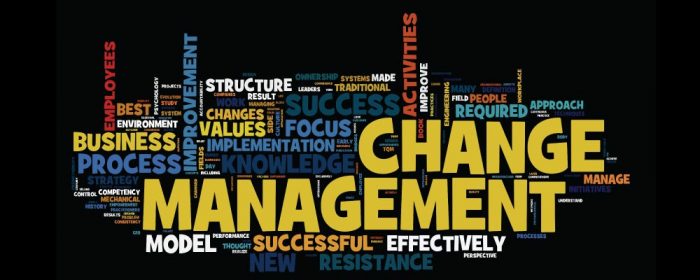Change management, or management of change, has become one of the most critical factors for success in the modern world. In this article, we will talk about the 7 R’s of change management.
Why is that? Well, it is because the project development process and all the other factors related to the project are not that stable, and they have to be changed ever so often because of the changing requirement of the market.
That’s why project managers have to incorporate a process of change management in their development strategy to make sure that any changes that come in the way of their development process being a success, can be dealt with, with ease.
Let’s discuss the definition of change management in detail.
What is Change Management?
The systematic approach that deals with the transition or transformation of different organizational goals, processes, core values, or technologies is called the Change Management process. This concept is also called ‘management of change,’ where several aspects of managerial strategies are changed for better and long-lasting results.
The main reason why companies incorporate a change management process in their overall workflow is that they want to successfully implement different methods and strategies of change in their development processes which ultimately helps the people to adapt to the change.
Pro Tip: Are you facing trouble in setting up milestones for your tasks and projects? Don’t you worry! You can do it in a few clicks with, nTask | Work Management Software, It’s about time you dot you I’s and cross your Ts to perfection!
What are the Three Types of Organizational Change?

The following are the three most important types of Organizational changes that also fall under the category of ‘management of change’:
- Transitional Change: These are the changes performed by the project managers or the high-level officials to steer the company away from one direction into another to make sure that the problem that the company is facing is solved. These included mergers, automation, and acquisitions.
- Developmental Change: Any changes made in the company’s policies or in the project development processes to ensure that the already established processes are optimized and improved.
- Transformational Change: These changes are the most impactful as they change the fundamental concepts on which the company is based, the operations and the core values that the company holds dear.
What are the 7 R’s of Change Management?
The famous 7 R’s of change management are the most important points that are to be considered in the whole change management process. These points are invoked in the conversation whenever anyone wants to make a change request regarding anything in the organization.
These points are important because they help in normalizing the change management process for those people associated with the project or the organization that is skeptical and wants everything to remain the same.
These 7 R’s of management of change checklist consist of 7 simple questions.
- The REASON behind the change?
- RISKS involved in the requested change?
- RESOURCES required to deliver the change?
- Who RAISED the change request?
- RETURN required from the change?
- Who is RESPONSIBLE for creating, testing, and implementing the change?
- RELATIONSHIP between suggested change and other changes?
Let’s discuss all of these questions in detail.
1. The REASON behind the change?

Why was the change requested by the upper management or the project managers related to the project? What was the reason behind this change request?
There can be many reasons regarding the processes of the company or the project development process, but the most common reasons for a change request are as follows:
- Capacity increase of a project element or some other element associated with the company
- Availability increase is also a viable reason for a change request
- Minimizing a security risk can also be one of the reasons to invoke a change request
No matter the reason for the change request, the entity that is filing for change must present a credible evidence trail or a persuasive argument to support its push for change.
This evidence must be submitted to the board to investigate and approve the change request.
One thing you have to ensure is to align all of the changes being proposed with the IT strategy and business objectives associated with the organization. This will help you avoid the expenditure of valuable resources on unnecessary changes.
2. RISKS involved in the requested change?

What are the risks associated with the changes that have been proposed in the change management process?
You have to understand that there is risk associated with literally everything included in the project development process and every entity associated with the organization.
The risks can be major like the company shutting down or something less fatal like losing a chunk of data during a system upgrade.
The question is how much risk are you going to allow to make sure that the changes can be administered with that risk present and there isn’t any fatal damage to the whole shebang.
3. RESOURCES required to deliver the change?

What are the resources required to administer the change the company is proposing or the project manager is rooting for?
Whenever we talk about the project development process, we talk about the budget and resource pool available for the project to be a definite success.
Suppose the company doesn’t have the money to back the project development process or doesn’t have the required or recommended personnel to finish the job. In that case, they will never complete the project in time or even after the deadline.
That’s why even when you are rooting or proposing a change request, you need to ensure that you have the right resources to complete the change management process; otherwise, you’re just shouting in the wind with no outcome.
To measure your resource pool, you first need to make sure you know about all the resources needed for your change management process. When you narrow that down, you can check the resource pool for those resources; if they are available, you will be victorious.
Related: 6 Important Causes of a Failing Change Management Process
4. Who RAISED the change request?
Moving on with the concept of management of change, you need to ensure at the start of the process is to know the person who raised the change request in the first place.
You need to do this because in the future it gets very hard to pinpoint the person who initiated the request because of the mayhem everywhere.
This person is extremely valuable for you because they are the ones with the evidence to support the change request process which they have to submit to the board as quickly as possible so that the change request can be accepted as soon as possible and the work can begin.
5. RETURN required from the change?

What is going to be the outcome of the change that you are trying to get implemented in the whole scenario?
Let’s say that you are working on a software development process and you are trying to add a new feature to the software.
You need to make sure that the return that you are going to get from that feature being introduced in the project is sufficient enough to perform the change in the first place, otherwise, there is no point in making a change request.
This is why you must make a pros and cons list of every change that you are trying to enforce so that you can check the returns you can get from every change being incorporated.
6. Who is RESPONSIBLE for creating, testing, and implementing the change?
One thing you need to make sure of is to find the right person that is going to be in charge of the creation, testing, and implementation of the change that you are trying to propose.
This is where upper-level management or project management comes into play because they have the authority and the mindset to appoint a suitable candidate for the job so that the change management process can go smoothly without any hiccups.
7. RELATIONSHIP between suggested change and other changes?
You need to find out about the relationship between the change that you are proposing and all of the other changes that are swirling around your change management process.
This process is done because most of the time we see in the organizational paradigm, that the changes not unlike tasks and processes are dependent on each other. One can’t happen without the other happening first.
This is why it’s your job to find out the relationship between all of the different tasks so that you can complete all of those dependencies and get your change incorporated.
Successful Change Management Examples
Change management is a rewarding process if done right, for the employees as well as the organization itself. Each step of the process paves the way to success and ultimately reaps beneficial results.
Following are some of the most successful change management examples in the business world:
Netflix:
Launched in 1997, Netflix has now become one of the giants in the video-on-demand streaming site with subscription based paying plans. Previously however, Netflix offered a monthly subscription plan with DVDs mailed to subscribers doorstep.
The rapidly changing technological arena, however, forced the organization to make a change in order to cater to the changing digital needs. To do so, they launched a streaming service in 2007. The change in their business plan was a successful move since they saw a rapid growth in their number of subscribers, from 23 million in 2011 to 167 million in 2019.
Nokia:
Nokia led the mobile market in early 2000s but all that changed with the launch and popularity of smartphones. Before smartphones became popular, Nokia had the largest market share in terms of mobile phones.
However, it lost the opportunity to evolve by skipping the smartphone revolution. As a result, Nokia became outdated and almost went bankrupt. To get back on its feet, Nokia sold its mobile phone division to Microsoft.
To further curtail the damages, they went from nine to four and eventually three business untis. As of 2018, Nokia is still a major patent licensor for many large mobile phone vendors and is the world’s third-largest network equipment manufacturer.
Lego:
We know lego as a toy, but as an organization, Lego has a history of one of the successul change management example. The brand completely change its course by adopting digital transformation and stepping into the digital realm.
It powered through and emerged from the ashes of over $800 million in debt and has completely turned the situation around in its favor. As of now, the company has a market value of around $9.1 billion dollars.
Looking for the best online change management resources?
Now that you understand the basics of the change management system and the 7Rs of change management, the next step would be looking for appropriate change management resources that can help you accelerate the process and produce optimum results.
When looking for the best online change management resources, it is important to consider the specific needs and goals of your organization. Some important factors to consider include the type of change you are implementing, the size and complexity of your organization, and the level of support and resources you need.
Resources that fit your requirements best and are within your budget should be at the top of your priority list.
Ultimately, the best online change management system resource will depend on your organization’s specific needs and goals. That is why it is important to research and evaluate the options that best fit your organization’s needs.
What are the most used types of change management?
When it comes to change management, there are several types of change management that are widely popular in organizations all over the world. Some of the most popular ones include:
- Organizational Change Management: This type of change management focuses on managing change at the organizational level. It involves creating a change management plan, communicating the plan to stakeholders, and then implementing the change.
- Process Change Management: This type of change management focuses on managing changes to business processes within an organization. It involves identifying the current process, designing the new process, testing the new process, and then implementing it.
- IT Change Management: This type of change management focuses on managing changes to IT systems within an organization. It involves identifying the current IT systems, designing the new systems, testing the new systems, and then implementing them.
- Cultural Change Management: This type of change management focuses on managing changes to the culture of an organization. It involves identifying the current culture, designing the new culture, testing the new culture, and then implementing it.
- Change Management in Project Management: This type of change management is a specific approach to managing changes that occur during a project. It involves identifying potential changes, assessing the impact of those changes, and then implementing the changes in a controlled and structured way.
It’s important to note that the type of change management used will depend on the specific change that the organization is trying to implement, and the best approach will be an integration of different methodologies depending on the organization’s specific needs.
FAQs
1. Which change management approach works best?
1. Lewin’s change management model
2. ADKAR change management model
3. Kübler-Ross change management framework
4. The McKinsey 7-S model
5. Kotter’s change management theory
6. Bridges transition model
7. Nudge theory
2. How important is the management of change for small businesses?
Successful management of change will produce beneficial results for the small business and will be rewarding in the long run.
3. What is the concept of change management?
It is a holistic approach that encompasses the management of the people side of change, as well as the technical and process side of change.
The goal of change management is to minimize the negative impact of change and maximize the positive impact of change.
Change management can be applied to various types of changes such as organizational change, process change, IT change, cultural change, and change management in project management. It is important to use appropriate change management methods that align with the specific change that the organization is trying to implement.
Overall, the concept of change management helps organizations respond to changing business needs and enables them to adapt and remain competitive in an ever-changing business environment.
4. How important is change management methodology?
It provides a framework for planning, communicating, and implementing changes in a way that minimizes the negative impact of change and maximizes the positive impact of change. It also helps organizations identify and address potential issues, and evaluate the outcomes of change.
Having a change management methodology in place also helps organizations build a culture of change, where change is viewed as a natural and necessary part of the business. This is critical for organizations that need to be agile and responsive to changing business needs.
The importance of change management methods is also highlighted by the fact that change is a constant in the business world and organizations need to be able to adapt quickly to changing market conditions and customer needs. A consistent methodology in place helps organizations respond to change in a more effective and efficient way.
Additionally, the importance of change management is evident from the fact that having a change management methodology in place helps ensure compliance with industry regulations and standards, and minimizes the risks associated with change.
All in all, change management methodologies are a sure way of implementing positive changes and minimizing risks during the change management process.
Conclusion
This was our take on the 7 R’s of change management, but if you think that we missed something or there is something wrong with the content, feel free to contact us and we’ll get back to you.

